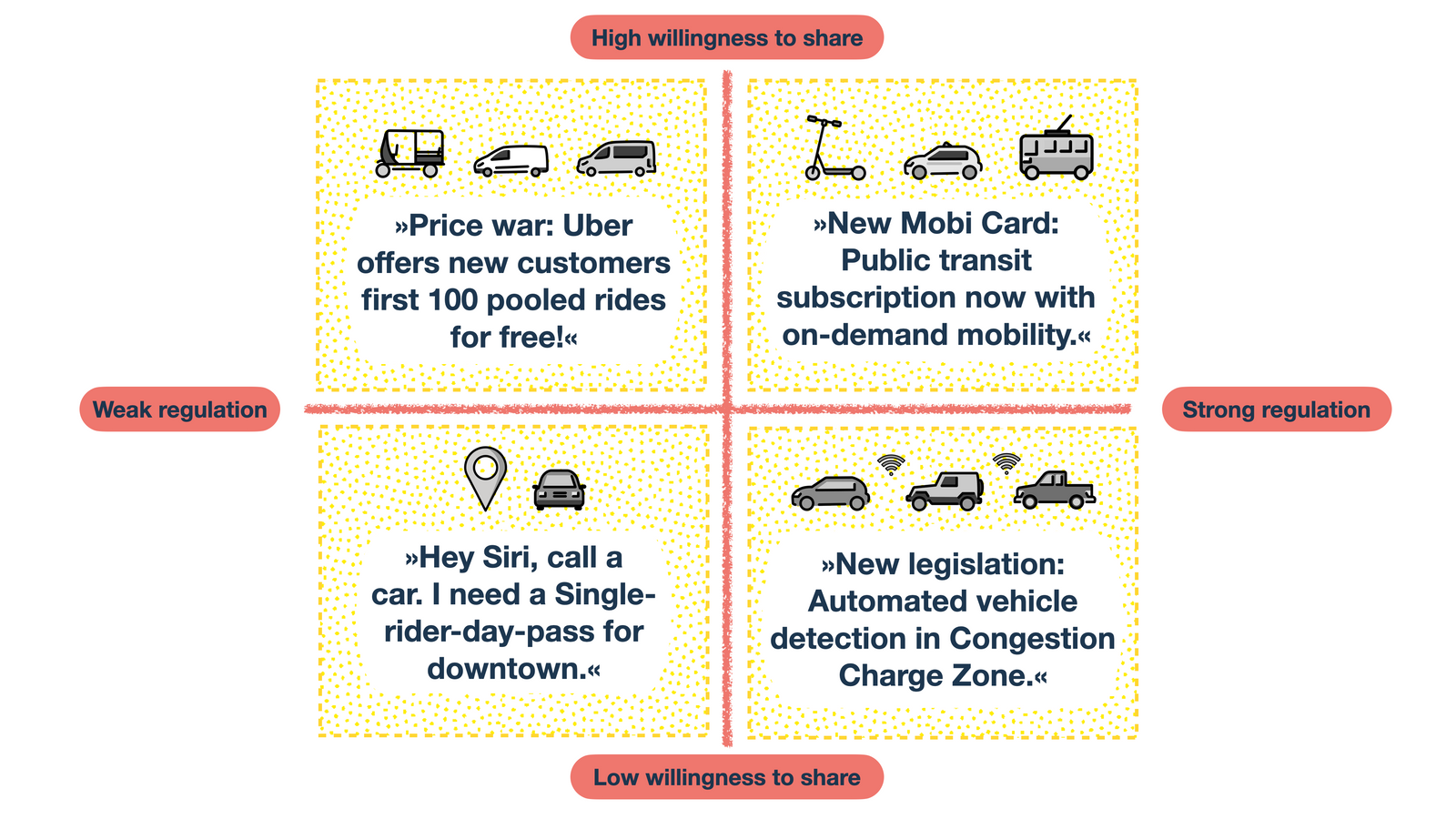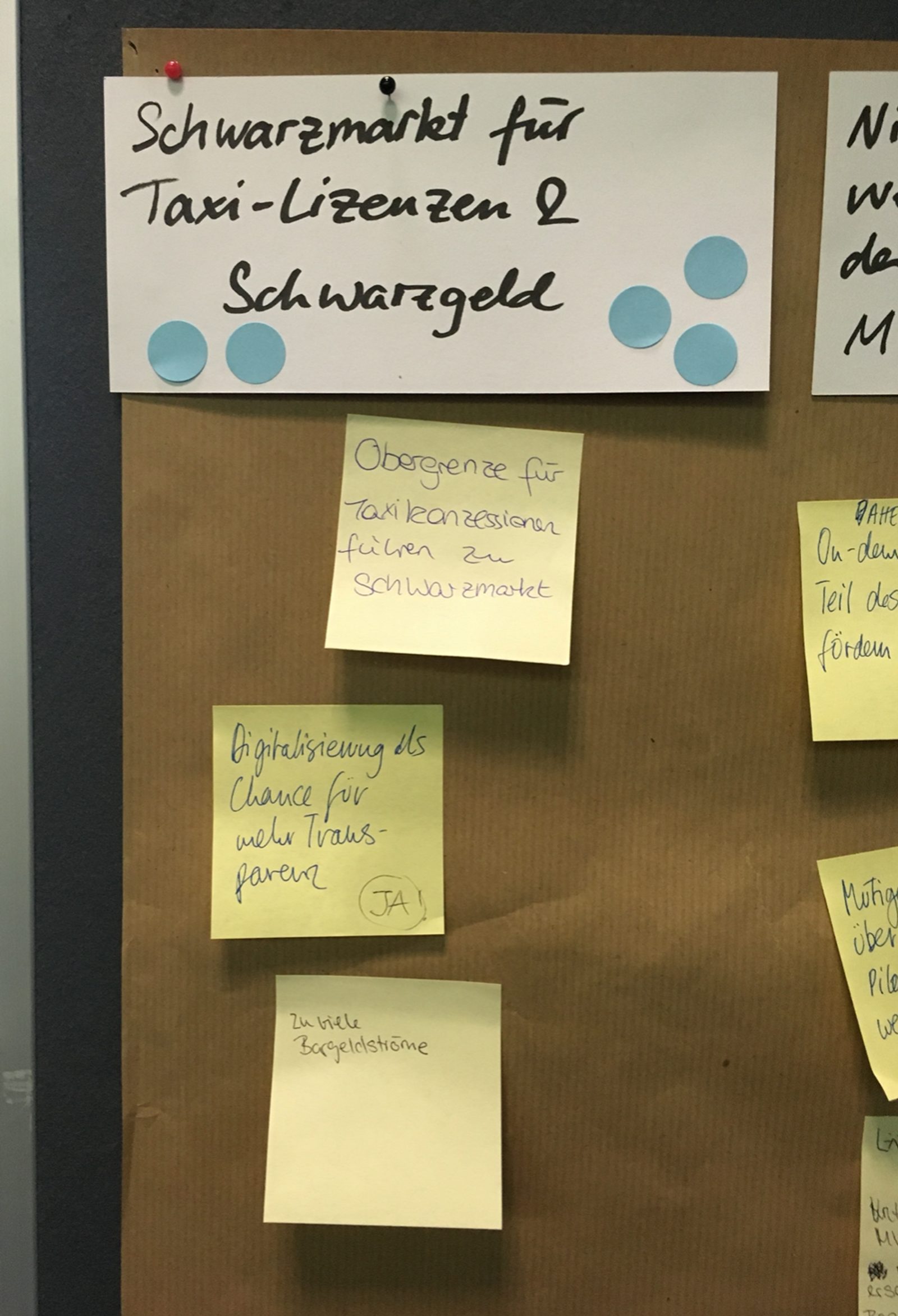Easyride — Showcasing autonomous driving in an urban context
What will be the impact of autonomous driving on urban mobility and public transport services? How should the public sector best manage and deploy this technology for the benefit of citizens? How must legislation change to mitigate the implications of individual mobility on urban life, landscape, and climate?
Autonomous driving will in some way or another affect future urban mobility. But rather than focussing merely on possible commercial applications in the form of private autonomous cars or luxury mobility services, the more pressing question is what the deployment of this technology will mean to urban life, landscape and climate.
If driving through traffic becomes a relaxing rather than a stressful activity, would this not increase the miles traveled by car? The “willingness to share” is a decisive criterion for leveraging the potential of autonomous driving for the positive development of the transport sector. Meaning a reduction of traffic, congestion, and land use in urban areas. In this respect, ride-pooling services have a particularly large potential by having strangers with similar routes share a vehicle.
Pooling people in one vehicle is - in essence - the core concept of puclic transport as we now it. Yet, today the pooling happens along specified lines and schedules. In future, public transport could pick you up when you want, where you want. Which will make riding by public transport much more attractive compared to today. However, people do not always willingly share their ride if they can afford to ride by themselves - as the success story of private car ownership clearly demonstrates. The implications of autonomous driving technology will be strongly influenced by two critical uncertainties:
- the willingness of the citizens to adopt shared mobility offerings
- the design of the legal framework regulating the mobility market in terms of prices, licences, operational requirements etc.
The project »easyride« focussed on four possible scenarios for 2030 which derive from different manifestations of these critical uncertainties (low to high willingness to share / weak to strong regulation).
While the willingness to share will be influenced by many aspects (such as the service quality and frequency, pricing of on-demand services and urban lifestyle), regulation will directly affect which kind of mobility services can be offered and by whom. E. g. autonomous driving technologies could be deployed in the market as ride-hailing services similar to uber and Lyft (top left), as robo taxis or private chauffeur services (bottom left), as part of the public transit eco-system (top right) or as private pods operated under advanced traffic management and road princing schemes (bottom right). Which of these futures is seen as desirable depends on who is asked. The different market players and stakeholders - lisenced taxi companies, public transport authorities, OEMs and mobility start-ups, city councils, regional commuters, citizens - all have their own views where and how autonomous driving technology should be used.
Autonomous driving represents a huge opportunity to transform mobility. Road safety would increase, and drivers would have more time to relax in vehicles rather than focus on the road.
A great opportunity for discussing desirable futures of urban autonomous mobility was the upcoming amendment of the Passenger Transportation Act (in german: Personenbeförderungsgesetz or short PBefG). The PBefG regulates all transport types that can be offered and operated on public infrastructure in Germany such as scheduled public transport services, but also taxi, chauffeur, and limousine services. In 2018, an amendment of this legislation was discussed to reflect future transport types such as autonomous on-demand services.
To discuss these proposed scenarios in more depth, the »easyride« team engaged with relevant stakeholders and market players in a series of workshops. These stakeholder dialogues helped to gather insights into today’s operational pain points, future challenges, and specific requirements for regulation that will enable deploying autonomous driving technology for on-demand services while protecting market participants from uncontrolled price wars and thereby providing attractive and viable mobility for all citizen. These efforts resulted in recommendations passed on to the Federal Ministry of Transport and Digital Infrastructure and served as a basis for designing a policy amendment.
Project outcome
After years of consultation and political discourse, a compromise was reached between all market players, lobby groups, and political parties. In August 2021, changes in passenger transport law came into force, creating a dedicated legal basis for new digital mobility offers/services and business models. Until then, these services were mostly authorized on the basis of an experimentation clause.
Articles and press
-
articleVerabschiedet euch vom Taxi, wie ihr es kennt @ GründerszenePBefG amendment mentioned on Gründerszene2021-11
-
articleSharing Economy trifft ÖPNV – das neue Personenbeförderungsgesetz @ WirtschaftsdienstArticle »Sharing Economy trifft ÖPNV – das neue Personenbeförderungsgesetz« @ Wirtschaftdienst 2021, Issue 10, p. 789–7942021-10
-
articleModerne Personenbeförderung – fairer Wettbewerb, klare Steuerung @ Federal Ministry for Digital and TransportArticle »Moderne Personenbeförderung – fairer Wettbewerb, klare Steuerung« @ Bundesministerium für Digitales und Verkehr, online2021-08
-
pressIm verschärften Wettbewerb @ IHK-MagazinProject »easyride« mentioned on IHK-Magazin2021-05
-
articleBundestag reformiert das Recht der Personenbeförderung @ Deutscher BundestagArticle »Bundestag reformiert das Recht der Personenbeförderung« @ Deutscher Bundestag, online2021-03
-
pressSollte man Taxis vor Konkurrenten wie Uber schützen? @ Der TagesspiegelPBefG amendment mentioned on Der Tagesspiegel2021-03
-
pressFahrdienste bekommen mehr Freiheiten @ SPIEGEL onlinePBefG amendment mentioned on SPIEGEL online2021-03
-
pressBundesrat winkt Reform des „Taxigesetzes“ durch @ Auto Motor SportPBefG amendment mentioned on Auto Motor Sport2021-03
-
pressDas Reförmchen @ zdf heutePBefG amendment mentioned on zdf heute2021-03
-
pressFahrdienste bekommen mehr Freiheiten @ BZPBefG amendment mentioned on BZ2021-02
-
pressReferentenentwurf zur PBefG-Novelle: Münchens Oberbürgermeister äußert sich sehr kritisch @ TAXItimesProject »easyride« mentioned on TAXItimes2020-07
-
articleVerabschiedet euch vom Taxi, wie ihr es kennt @ GründerszenePBefG amendment mentioned on Gründerszene2021-11
-
articleModerne Personenbeförderung – fairer Wettbewerb, klare Steuerung @ Federal Ministry for Digital and TransportArticle »Moderne Personenbeförderung – fairer Wettbewerb, klare Steuerung« @ Bundesministerium für Digitales und Verkehr, online2021-08
-
articleBundestag reformiert das Recht der Personenbeförderung @ Deutscher BundestagArticle »Bundestag reformiert das Recht der Personenbeförderung« @ Deutscher Bundestag, online2021-03
-
pressFahrdienste bekommen mehr Freiheiten @ SPIEGEL onlinePBefG amendment mentioned on SPIEGEL online2021-03
-
pressDas Reförmchen @ zdf heutePBefG amendment mentioned on zdf heute2021-03
-
pressReferentenentwurf zur PBefG-Novelle: Münchens Oberbürgermeister äußert sich sehr kritisch @ TAXItimesProject »easyride« mentioned on TAXItimes2020-07
-
articleSharing Economy trifft ÖPNV – das neue Personenbeförderungsgesetz @ WirtschaftsdienstArticle »Sharing Economy trifft ÖPNV – das neue Personenbeförderungsgesetz« @ Wirtschaftdienst 2021, Issue 10, p. 789–7942021-10
-
pressIm verschärften Wettbewerb @ IHK-MagazinProject »easyride« mentioned on IHK-Magazin2021-05
-
pressSollte man Taxis vor Konkurrenten wie Uber schützen? @ Der TagesspiegelPBefG amendment mentioned on Der Tagesspiegel2021-03
-
pressBundesrat winkt Reform des „Taxigesetzes“ durch @ Auto Motor SportPBefG amendment mentioned on Auto Motor Sport2021-03
-
pressFahrdienste bekommen mehr Freiheiten @ BZPBefG amendment mentioned on BZ2021-02
-
articleVerabschiedet euch vom Taxi, wie ihr es kennt @ GründerszenePBefG amendment mentioned on Gründerszene2021-11
-
pressIm verschärften Wettbewerb @ IHK-MagazinProject »easyride« mentioned on IHK-Magazin2021-05
-
pressFahrdienste bekommen mehr Freiheiten @ SPIEGEL onlinePBefG amendment mentioned on SPIEGEL online2021-03
-
pressFahrdienste bekommen mehr Freiheiten @ BZPBefG amendment mentioned on BZ2021-02
-
articleSharing Economy trifft ÖPNV – das neue Personenbeförderungsgesetz @ WirtschaftsdienstArticle »Sharing Economy trifft ÖPNV – das neue Personenbeförderungsgesetz« @ Wirtschaftdienst 2021, Issue 10, p. 789–7942021-10
-
articleBundestag reformiert das Recht der Personenbeförderung @ Deutscher BundestagArticle »Bundestag reformiert das Recht der Personenbeförderung« @ Deutscher Bundestag, online2021-03
-
pressBundesrat winkt Reform des „Taxigesetzes“ durch @ Auto Motor SportPBefG amendment mentioned on Auto Motor Sport2021-03
-
pressReferentenentwurf zur PBefG-Novelle: Münchens Oberbürgermeister äußert sich sehr kritisch @ TAXItimesProject »easyride« mentioned on TAXItimes2020-07
-
articleModerne Personenbeförderung – fairer Wettbewerb, klare Steuerung @ Federal Ministry for Digital and TransportArticle »Moderne Personenbeförderung – fairer Wettbewerb, klare Steuerung« @ Bundesministerium für Digitales und Verkehr, online2021-08
-
pressSollte man Taxis vor Konkurrenten wie Uber schützen? @ Der TagesspiegelPBefG amendment mentioned on Der Tagesspiegel2021-03
-
pressDas Reförmchen @ zdf heutePBefG amendment mentioned on zdf heute2021-03












